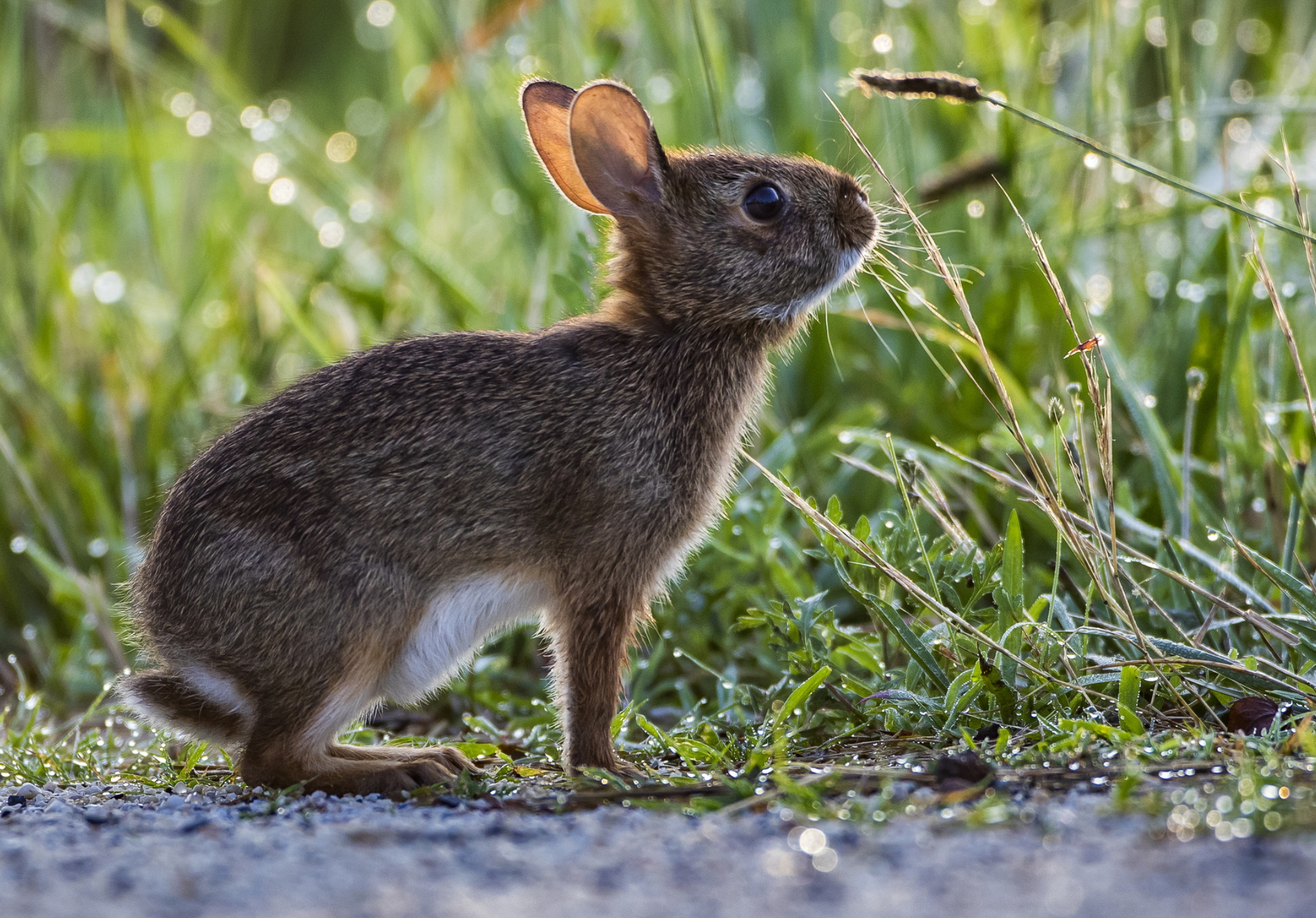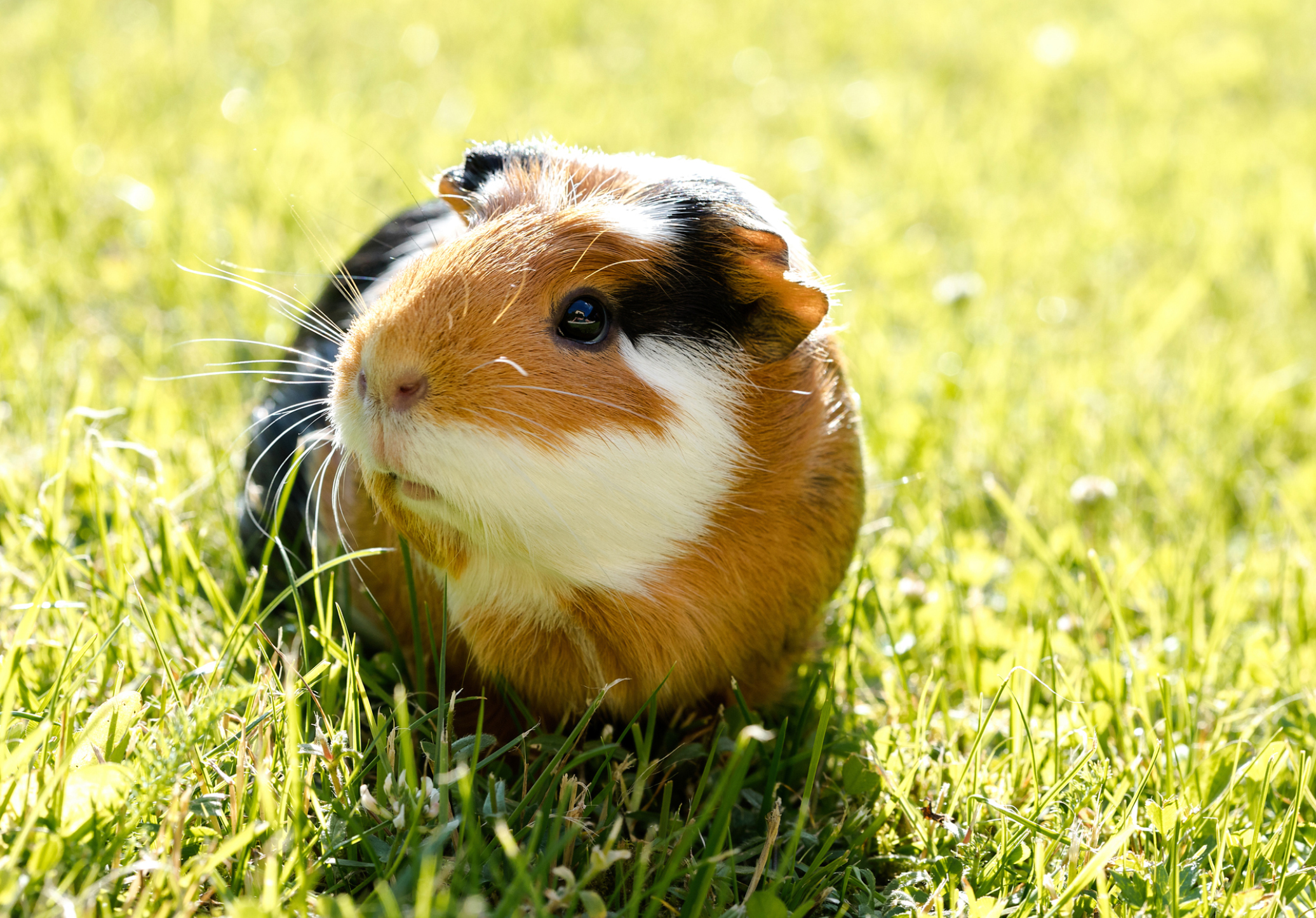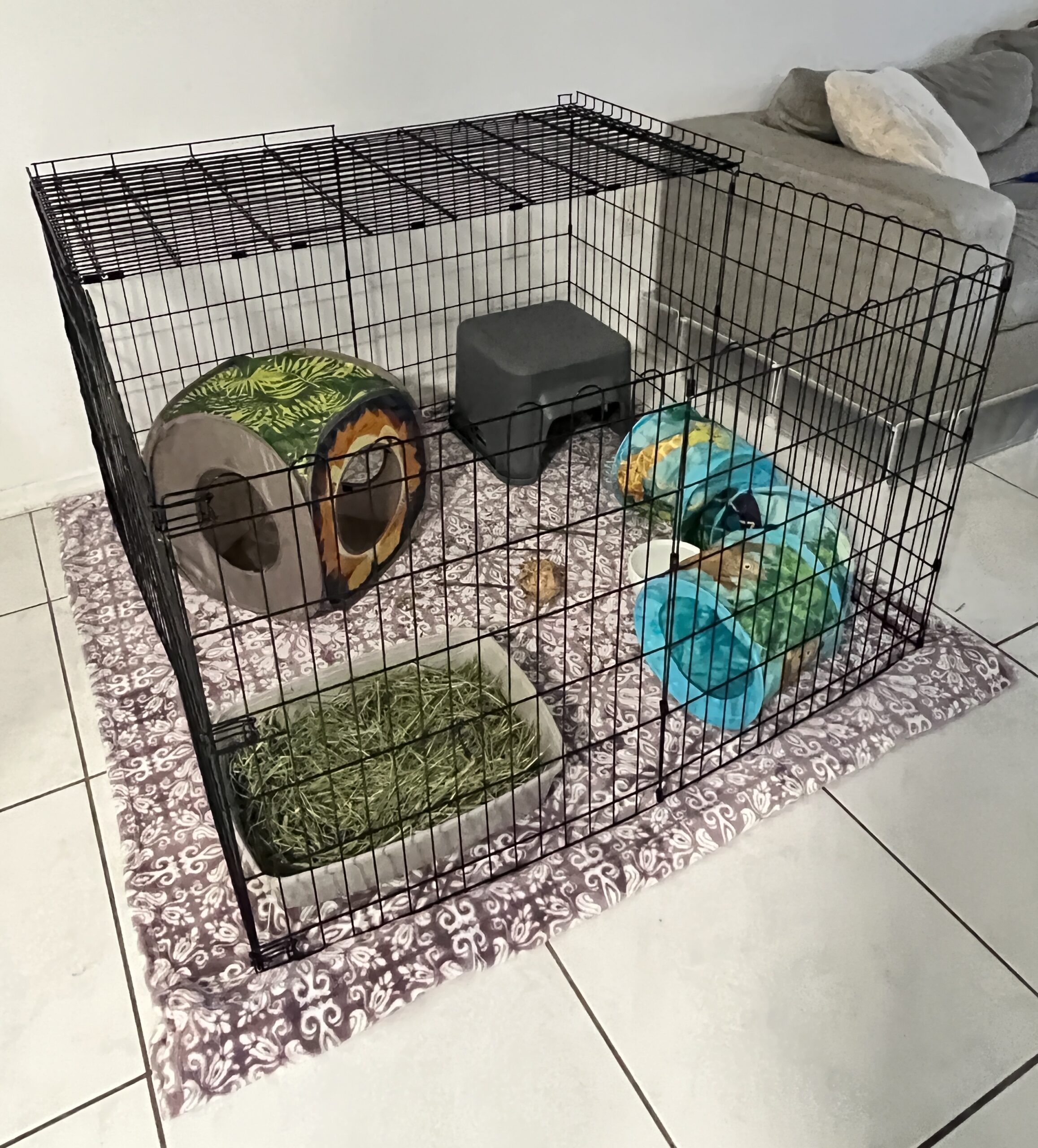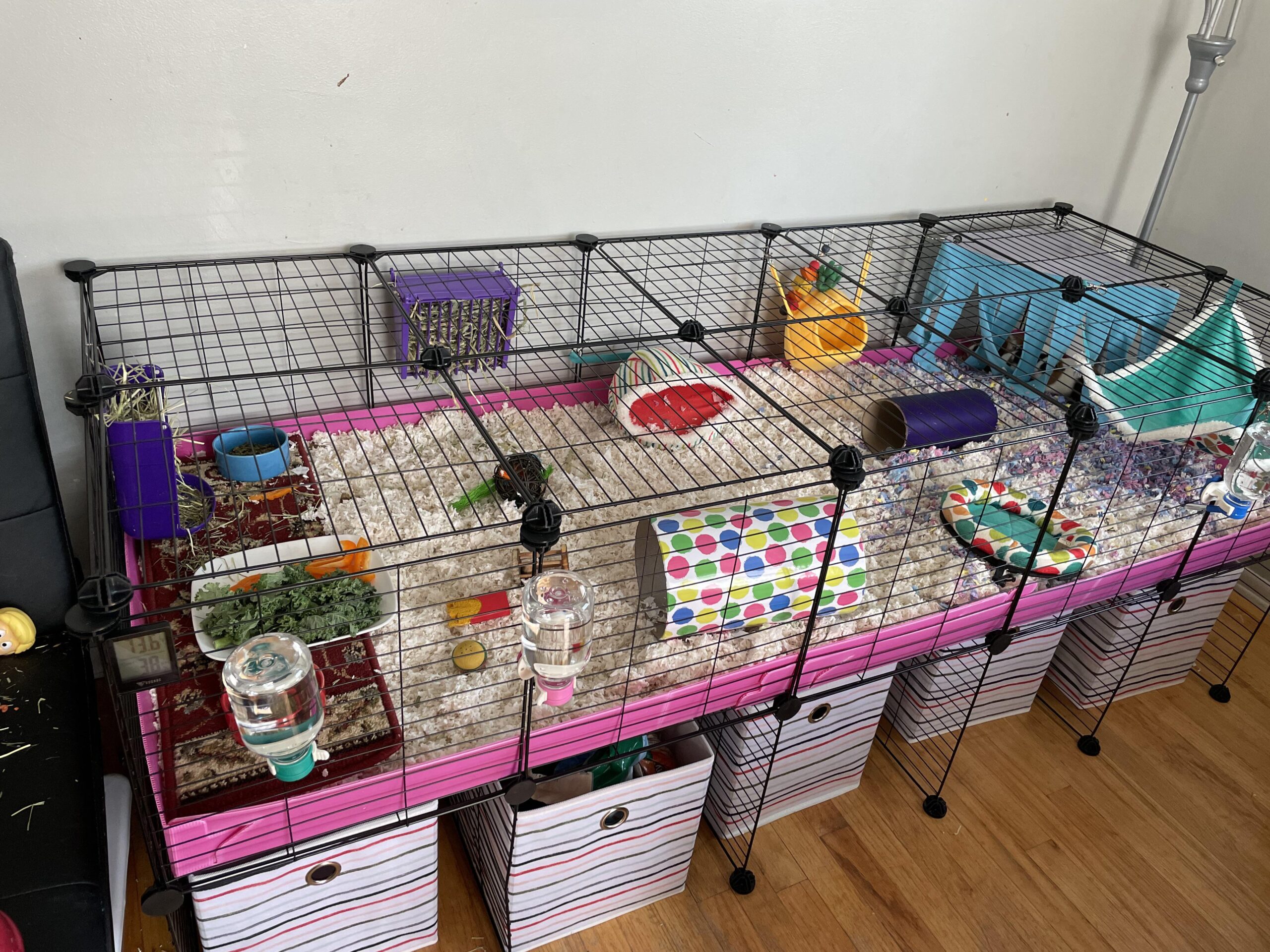HELP! I Found a Rabbit (or Guinea Pig) Outside!
If you see a rabbit or guinea pig outside, there are 2 things to consider before bringing them home:
1 | Is It a Wild or Domestic?
WILD RABBIT:
- BODY SHAPE: lean and thin. Small eyes and shorter, round ears.
- SIZE: small, usually 2.2lb (1kg).
- COLOR: short, multicolored, dark and light speckled coat or “agouti” fur type. The abdomen and tail may be a lighter or cream color.
- TEMPERAMENT: always on high alert and very fast. Runs away quickly if approached.
Wild rabbits will be smaller and thinner than their domestic counterparts, with smaller eyes and ears. They are leaner and have more muscle mass as they spend their lives digging shelters, running away from predators and foraging for food and water. They will run away quickly if approached.
Unless injured or a baby, it will be very difficult to catch a wild rabbit.
DOMESTIC RABBIT:
- BODY SHAPE: more rounded body shape; longer ears.
- SIZE: size may vary from 3-14lb (1-6kg).
- FUR: domestic rabbits come in a variety of colors (white, black, tan, red, brown) and patterns; may be short or long haired.
- TEMPERAMENT: less alert. May allow humans to approach more closely before running away. May approach for food or help.
Domestic rabbits are rounder and fatter than their wild counterparts. The have likely spent their life locked in a small cage or hutch without adequate room for exercise and overfed leading to obesity. Domestic rabbits lack the skills and instincts needed to find food and avoid dangers. They come in a variety of sizes, colors and breeds. Some even have the “agouti” coloring of a wild rabbit but with a different body shape. They may approach humans for food or help.
DOMESTIC GUINEA PIG:
- BODY SHAPE: potato.
- SIZE: smol.
- FUR: provides 0 camouflage.
- TEMPERAMENT: skittish.
This furry potato is build to feed, not for speed. Weighing in at just 800-1000g guinea pigs have no natural defenses and cannot survive in the wild. Their bright colors and high pitched squeaks attract predators, who they cannot outrun on their short legs.
2 | Can You Care For Them?
A good Samaritan may rescue a rabbit or guinea pig they found outside or from a bad situation thinking that they will easily find the owner or a place to take them. However, after reaching out to shelters and rescues, they may find that not all shelters accept small animals, and rescues are few, far and often already full. It is unlikely that an owner will come forward as rabbits and guinea pigs are often dumped outside intentionally and finding them a home on your own can be more difficult than anticipated.
Caring for a rabbit or guinea pig also requires a significant time and financial commitment. Before bringing a rescue home, make sure you that are prepared to care for them for a few weeks or even months. Have a look at our Rabbit and Guinea Pig Care Guides to learn more about their specific needs.
They will also need to be kept separate from any other animals in the home as they may have have a respiratory infection or parasites. Pneumonia or other illnesses and fleas, ticks, lice, mites, and worms are common in animals that are found outside and will need to be treated by a veterinarian.
If You Have Brought Them Home
3 | Housing & Supplies
Cages, hutches and dog creates DO NOT provide enough living space for rabbits or guinea pigs but may serve as a safe temporary enclosure for up to 2 weeks if no other option is available.
PRO TIP: Unless you already have a cage or hutch DO NOT spend money to get one, they can cost $100-200. Instead get a 30-36 inch tall “MidWest Metal Dog Exercise Pen” for rabbits ($45) or a “MidWest Guinea Pig Habitat” for guinea pigs ($65).
RABBITS:
- FLOORING: Rabbits have sensitive feet and need soft flooring in their area. You can get a 50in x 70in oversized blanket from Ross or TJ Maxx for $12-16. Do not use rugs or carpets until after you have completed treating any potential parasites.
- LITTER BOX: (minimum size: 14in x 18in) L or XL high sided cat liter box like the “Arm & Hammer Litter Box” or the “So Phresh Litter Box“.
NO: plastic or metal grids as these are not comfortable for rabbits feet and can cause sore feet, broken nails or toes if their feet get caught. - LITTER: “Oxbow Eco-straw“, “Recycled Paper Pellets” must be unscented and have no baking soda; Oxbow, Small Pet Select and Kaytee offer “paper bedding” however this type of litter will need to be changed more often, doesn’t cover odors and may be more messy as rabbits tend to kick it out of the litter box when they jump out. “Tractor Supply Pine Pellets” are a safe, low cost litter.
NO: clay or clumping cat litters; or soft wood shavings such as aspen, cedar, pine, walnut as these can cause skin, eye and respiratory irritation. - FOOD / WATER BOWLS: (minimum size: 3 – 5 cup capacity) Use a heavy ceramic water bowl for water. It should be heavy enough that the rabbit cannot fling it or tip it over, plastic and metal bowls are not heavy enough. Food bowls are optional. Food pellets can be scatter fed to encourage foraging and fresh greens can be hand fed to encourage bonding.
NO: water bottles. - HIDING AREA: As prey animals, rabbits need a safe place to run and hide. Give them a “Cardboard Houses” or “Tunnels” to retreat to. You can also use a cardboard box but be sure to remove all tape and shipping labels.
- FOOD a balanced diet consists of mostly hay, vegetables and greens, fortified pellets. See below.
GUINEA PIGS:
- BEDDING: For soft bedding, we recommend “Oxbow Pure Comfort“, “Small Pet Select Unbleached White Paper Bedding“, “Small Pet Select Pelleted Paper Bedding“, or “Kaytee Clean & Cozy“. You can also get a washable cage liner at “Guinea Pig Market“, “Guinea Dad“, “Kavee“, or “Etsy“.
AVOID: all wood shavings including aspen, cedar, pine, walnut as these can cause skin, eye and respiratory irritation. - WATER BOTTLES: get at least 1 water bottle per guinea pig to prevent resource guiding. Guinea pigs may hoard a single water source and keep other guinea pigs from drinking.
- HIDING AREA: get at least 1 hidey house per guinea pig. For the same reason, you’ll want to provide 2 identical hidey houses to prevent one guinea pig from being left out or fighting over a more desirable house. Any tunnels, cuddle cups, cuddle sacks and hanging corners should also be provided in twos.
- FOOD a balanced diet consists of mostly hay, vegetables and greens, fortified pellets. See below.
4 | Recommended Diet
One of the most common mistakes we see is giving rabbits and guinea pigs large amounts of cabbage, iceberg lettuce, corn, fruits or carrots to eat.
PRO TIP: Never feed corn or iceberg lettuce as it can cause GI upset, instead get spring mix and feed according to the guide below. Rabbits and guinea pigs shouldn’t get more than 1-2 teaspoon size servings of fruits per week. That’s about the size of 1 strawberry or 1 baby carrot PER WEEK.
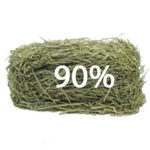
80-90% of a rabbit and guinea pigs diet should be high quality grass hay.
- Juvenile rabbits and guinea pigs (up to 6 months): Alfalfa Hay
- Adult rabbits and guinea pigs (6 months +): Timothy Hay
PRO TIP: You can get a 90oz bag of Oxbow Timothy Hay at your nearest pet store for about $20, it will last 2-3 weeks.

10% of a rabbit and guinea pig’s diet should be green leafy vegetables. Organic vegetables (no pesticides) are recommended whenever possible. Always remove seeds as these are a choking risk.
- Baby rabbits and guinea pigs: NO greens or vegetables.
- Juvenile rabbits and guinea pigs: can start to have small amounts of vegetables introduced into their diet at 2 months old (guinea pigs) and 3 months old (rabbits). Vegetables should be introduced gradually, one per week, so that you can monitor for sensitivity or stomach upset. If any vegetable seems to cause digestive problems do not feed it in the future.
- Adult rabbits and guinea pigs: can have 1/2 cup (guinea pigs) and 1-2 cups (rabbits) of leafy greens and 1-2 tablespoon of non-leafy green vegetables per day.
You can feed green leaf, red leaf and butter leaf lettuces daily. Other leafy greens like romaine, spinach, kale, turnip greens, dandelion greens, arugula, bok choy, and watercress and herbs like cilantro, basil, parsley, mint, and dill can be offered for variety 1-3 times per week.
You can also feed the following non leafy vegetables: bell peppers, celery (remove veins or cut into small pieces), cucumber, green beans, broccoli, brussel sprouts and radishes.
PRO TIP: remove seeds from peppers and cucumbers as they are a chocking and obstruction risk for rabbits and guinea pigs.

5% of a rabbit and guinea pig’s diet should be fortified food pellets.
- Baby rabbits and guinea pigs (up to 3 months): unlimited alfalfa based pellets.
- Juvenile rabbits and guinea pigs (3-6 months): 1 tbsp (guinea pigs) and 4tbsp (rabbits) of alfalfa based pellets.
- Adult rabbits and guinea pigs (6 months +): 2tbsp (guinea pigs) and 2tbsp of pellets per 2lb of body weight (rabbits).
We recommend: “Oxbow“, “Science Selective“, “Small Pet Select” or “Sherwood“.
PRO TIP: Avoid “Mix” pellets and treats with seed and corn can lead to chocking and malnutrition due to selective eating. The first ingredient listed for pellets should be timothy hay for adult rabbits and guinea pigs or alfalfa hay for young rabbits and guinea pigs.

Less than 5% of a rabbit and guinea pig’s diet can be fruits and treats. Feed no more than 1-2 teaspoon size servings of fruits per week. That’s about the size of 1 strawberry or 1 baby carrot.
What To Do Next
5 | Reach Out For Help
Most Florida Rabbit & Guinea Pig rescues are FULL or OVER CAPACITY. They receive anywhere from 10-60 request for help PER WEEK and it may take months on a wait-list before they can accept a rabbit or guinea pig into their care.
Be prepared to potentially have to drive as far as 5 hours away if a rescue or shelter has available space.
Below we will list rescues and shelters in Florida that may accept small animals but first we’ll share some questions you should ask before giving away the rabbits or guinea pig, common reasons rescues have to turn people away and ways that you can increase the chance your request is approved!
You can also try to find a home on your own by posting in this Florida Rehoming Group for Rabbits & Guinea Pigs: “FLORIDA RABBITS & GUINEA PIGS“
Questions To Ask
-
Do you provide veterinary care? What veterinarian do you use?
A legitimate rescue provides veterinary care with an experienced exotic veterinarian. Call the veterinarian to confirm if they are currently working with this rescue. If you are re-homing to a person who currently has rabbits or guinea pigs ask if they provide veterinary care for their current pets. If you are re-homing to someone who has never had rabbits or guinea pigs before, have them read this page to make sure they are up for the care: VETERINARIANS
-
Do you spay/neuter before re-homing? Do you breed rabbits or guinea pigs?
Florida law requires that animals adopted from shelters and rescue groups be sterilized. A legitimate rescues will spay/neuter all their animals before rehoming them and would never contribute to the exploitation and over population of rabbits and guinea pigs by breeding them.
-
Where do you keep your rabbits or guinea pigs? Can I see pictures of your setups?
Rabbits and guinea pigs can start to overheat at just 77 degrees. They should be housed and kept indoors at all times. Keeping them outdoors can cause them to die from heatstroke and exposes them to predators and parasites like fleas, ticks, worms, mites, fly strike and bot flies. Check the rescues website and social media to get an idea of how they care for their current animals. If you are re-homing to a person who currently has rabbits or guinea pigs, ask to see pictures of their current setup and supplies. If you are re-homing to a person who has never had rabbits or guinea pigs, have them read our Rabbit and Guinea Pig Care Guides and send you pictures of their supplies and setup before meeting.
-
Do you euthanize due to behavioral or medical issues or after they “time out”?
Rabbits are often very stressed out in metal kennels and may be labeled as aggressive or un-adoptable for lunging or cowering if hands reach in. These same rabbits will usually be completely non-aggressive in a home environment. Shelter’s may only be able to hold a rabbit or guinea pig for a week before they have to euthanize due to overcrowding and may not have the means or experience to provide complex treatments. There are some shelters that do provide veterinary care and spay/neuter small animals before adopting them out. If your local rescues is not able to accept the animal, ask if they can recommend a no-kill shelter to contact.
PRO TIP: Never advertise or give a rabbit or guinea pig away FOR FREE unless to a rescue or shelter. There are many nefarious reasons that people can get small animals for, including feeding them to large reptiles or using them as bait for dog fighting. Always ask for a re-homing fee (we recommend at-least $50). You can choose to waive this fee later for the right person. Keep in mind that someone who is not willing or able to pay $50 may not be able to afford to provide food or supplies which can cost about $80-100 per month.
Its important to screen people, even rescues, before giving a rabbit or guinea pig away. Ask if they provide veterinary care and what veterinarians they work with. Do they spay and neuter before rehoming their animals and do they ever breed them? Where will they be housing them? Rabbits and guinea pigs should be housed indoors as it is too hot in Florida for them to be outdoors. Ask to see pictures of their enclosures. Find them online or on social media to see if you can find posts that show they provide veterinary care, pictures of the animals outside, or promotions for new litters or baby rabbits and guinea pigs.
A reputable rescue will have no problem answering any of the questions above and explaining their protocols. If they become defensive, hostile, refuse to provide pictures or are not truthful, this is a big red flag that something might not be right.
3 Reasons a Rescue May Not Be Able to Help You
- SPACE: Unlike county shelters that can house large numbers of animals, have paid staff and are funded by the government. Small animal rescues are home based and run by volunteers. They will often have 2-3 rabbits or guinea pigs in multiple rooms in their house, including in the bathrooms or kitchen. They simply CANNOT create more space.
- COSTS: Every rabbit and guinea pig will costs at least $250-300 at intake. This includes a wellness exam, spay/neuter surgery, parasite treatment, and sometimes also a microchip and vaccination for rabbits. This does not include the cost food and supplies which is around $40-80 per month. And this is assuming the animal is healthy, if not, veterinary care can easily cost $900-1500 or more. Rescues are donation based and many times have to pay out of their own pockets to save an animal.
- TIME: Rescues are juggling trying to save small animals that are “timing out” at a shelter, living in dangerous situation or fending for their life outdoors. Its a race against time. They also have to take care of the rabbits and guinea pigs currently in their care. They spend hours each day feeding, cleaning up and spending time socializing with them. Image the amount of work 10 or more rabbits and guinea pigs may need each day. Some of whom may require medication administration and therapy multiple times a day. And this is in addition to any work, family and social commitments they might have.
Due to limited space, needing time to find placement for the animals that are currently in the rescue or on the wait-list, and the cost of veterinary care, a rescue may not be able to take your rabbit or guinea pig right away. It may be months before they have the space and resources available to be able to help you.
Below are ways you can help rescues and increase the chance your request will be approved:
NOT HELPFUL
- “If you do not take this animal I will put them back outside in a week” Threats will not create additional space or funds and neither will a short deadline. It is also cruel as the rabbit and guinea pig are will likely get hit by a car or attacked by a predator. If you or someone you know can keep the rabbit or guinea pig for a couple of weeks or months, a rescue is much more likely to be able to help you.
HELPFUL
- “I can foster until they get adopted” Space is often the biggest limiting factor for rescues. If you agree to foster until the rabbit or guinea pig is adopted, the rescue is more likely to approve your request. Keep in mind this can take 4-6 months or more, you will need to agree to follow the rescues care requirements and rescues may only accept fosters that are local to them.
- “I can help cover the cost of veterinary care and getting them spay/neutered” Before rehoming a rabbit or guinea pigs, a legitimate rescue will take them to a vet for a wellness exam, provide treatment for any parasites, and have them spay/neutered. This can cost around $250-300. If the animal is sick or injured, veterinary care can easily cost $900-1500 or more. Rescues are donation based and many times have to pay out of their own pockets to save an animal.
- “They are already spay/neutered and have been to the vet recently” You can also be pro-active and take them to the vet yourself to be examined and spay/neutered. Have a look at our VETERINARIANS page for a list of exotic veterinarians and low cost clinics and shelters that see rabbits and guinea pigs.
Rescues and Shelters in Florida
Rabbit Rescues
SOUTH EAST FLORIDA
East Coast Rabbit Rescue WEST PALM BEACH
www.eastcoastrabbitrescue.org
H.A.R.E. House Rabbit Adoption Rescue and Education MIAMI-DADE
www.hare.as.miami.edu
Penny & Wild SOSFL MIAMI-DADE & BROWARD
www.pennyandwild.org
SOUTH WEST FLORIDA
Southwest Rabbit Rescue LEE & COLLIER
www.respectforrabbits.org
CENTRAL EAST FLORIDA
Floppy Ear Rescue ST. LUCIE
www.floppyearrescue.org
Fort Wilbur Rabbit Rescue VOLUSIA
www.fortwilbur.org
Holly Hops Rabbit Rescue and Rehabilitation VOLUSIA
www.hollyhops.org
O.R.C.A. Orlando Rabbit Care and Adoptions ORANGE
www.orlandorabbit.org
The Pawphanage for Wayward Pets ORANGE
www.pawphanage.org
Space Coast Bunnies BREVARD
www.facebook.com/spacecoastbunnies
CENTRAL WEST FLORIDA
Suncoast House Rabbit Rescue PASCO
www.suncoasthrr.org
Tampa Bay Rabbit Rescue TAMPA
www.tbhrr.org
NORTH EAST FLORIDA
Bebette’s Bunny Rescue NASSAU
www.bebettesbunnyrescue.org
Gainsville Rabbit Rescue ALACHUA
www.gainesvillerabbitrescue.org
Live Freely Sanctuary ALACHUA
www.facebook.com/LiveFreelySanctuary
North Florida Rabbit Rescue DUVAL
www.northfloridarabbitrescue.org
Guinea Pig Rescues
As there is a shortage of guinea pig rescues in Florida this list will also include county shelters.
SOUTH EAST FLORIDA
Penny & Wild SOSFL MIAMI-DADE & BROWARD
www.pennyandwild.org
SOUTH WEST FLORIDA
Broken Oak Sanctuary LEE
www.brokenoaksanctuary.org
The Royal Cavy Guinea Pig Rescue Inc. HILLSBOROUGH & PINELLAS
www.theroyalcavyguineapigrescue.com
Bishop Animal Shelter SPCA MANATEE
www.bishopspca.org
Collier County Domestic Animal Services COLLIER
www.colliercountyfl.gov
Humane Society of Manatee County MANATEE
www.humanemanatee.org
Humane Society of Naples COLLIER
www.hsnaples.org
Humane Society of Tampa Bay HILLSBOROUGH
www.humanesocietytampa.org
SPCA of Tampa Bay HILLSBOROUGH
www.spcatampabay.org
CENTRAL EAST FLORIDA
Floppy Ear Rescue ST. LUCIE
www.floppyearrescue.org
The Pawphanage for Wayward Pets ORANGE
www.pawphanage.org
H.A.L.O No-kill Rescue INDIAN RIVER
www.halorescuefl.org
Humane Society of the Treasure Coast MARTIN
www.hstc1.org
NORTH EAST FLORIDA
Jacksonville Guinea Pig Rescue DUVAL
www.facebook.com/JaxGPR
Gainsville Rabbit Rescue ALACHUA
www.gainesvillerabbitrescue.org

